
Wine Culture and Information since 2002 - Volume 22
 Wine Culture and Information since 2002 - Volume 22 |
|
Comparing Barolo and BarbarescoThe two giants of Piedmontese enology, despite they are both made from Nebbiolo grapes, express different characters, fruit of the respective territories |
|
Among the many great grapes found in Italy, Nebbiolo certainly is one of those, with honor and quality, representing the wine making of Bel Paese all over the world. Piedmont and Lombardy are the two main regions where Nebbiolo is cultivated and with which are being produced magnificent wines. In Piedmont's Langhe, in Lombardy's Valtellina, Nebbiolo gives pretty unique qualities to the wines of the respective areas. Despite in Piedmont Nebbiolo is found in most of the territory, it is in the Langhe area this grape reaches the highest and most representative levels, by expressing both strength and the typical structure of wines produced with this grape, as well as elegance. It is not by chance wine produced with Nebbiolo, in particular the ones from Langhe, are usually defined as an iron fist in a velvety glove. This month we will compare the two main representatives of Nebbiolo wines produced in Langhe: Barolo and Barbaresco, two great wines which are just few kilometers apart one from each other.
|
King of wines, wine of the kings. About Barolo has been written and discussed a lot, it received in the course of the years the highest praises and the highest honors, it is one of the best representatives of Italian enology in the world. Barolo is generally defined as a “masculine” wine, because of its strong and robust structure, as well as for its power, where tannins play a fundamental role in the definition of its character. On this regard, it should be noticed Nebbiolo is among the red berried grapes having the highest content in polyphenols - mainly responsible for structure - however it is characterized by a relatively modest content in coloring substances. For this reason, Nebbiolo wines, including Barolo, are never characterized by low transparency, however the color always has an intense and brilliant ruby red hue. Barolo has been among the first wines in Italy to adopt the concept of cru, something which is still today scrupulously followed by producers and, generally speaking, in wines of Langhe. As opposed to other wines and territories in Italy, the production area of Barolo has been attentively studied in its characteristics and quality, by defining every single portion of the territory, a job started in 1980s by Renato Ratti. The concept of cru is so deep-rooted in the productive culture of Barolo, that virtually in the label of every bottle is mentioned the name of the vineyard and the territory of origin. Barolo is traditionally aged in wood containers - an useful practice in order to smooth the power of tannins - and which has been recently subject of debates. Traditionally speaking, Barolo is aged in large casks, a technique requiring long periods of time before giving back a more gentle wine. Some produced began to introduce the modern French barrique that, because of its smaller volume, allowed shorter periods of aging, while giving the wine a more evident woody character. The “debate” between traditionalists and modernists is still today alive, a debate dividing producers as well as Barolo lovers.
|
||||||||
|
Despite the power given by Nebbiolo grape, Barbaresco is generally defined as having a “feminine” personality, a character which is opposed to the “masculinity” of Barolo, in order to emphasize a higher elegance and finesse. Nevertheless, the distance between the two territories is really short: less than twenty kilometers separate Barolo from Barbaresco, the two villages giving the name to the two great wines of Langhe. Also the production territory of Barbaresco has been attentively studied according to the many crus found in the area. Just like Barolo, also Barbaresco producers enhance the many crus of the territory and the grapes harvested in every portion or cru are generally vinified and bottled singularly. It should however be noticed the wine making practice of singularly vinifying and bottling the grapes of every vineyard is very common in Piedmont, as well as it is common the production of monovarietal wines, that is produced with just one grape variety. Also in the area of Barbaresco wines are aged in wood containers - for the same reasons adopted for Barolo - and also here are being used both the traditional large cask, as well as the modern barrique, although - it should be noticed - in this area the “conflict” between traditionalists and modernists is practically negligible. Like we already said, the personality of Barbaresco is generally defined as “feminine”, a quality deriving from the comparison with the more “masculine” Barolo. This characteristic could be cause of confusion, making one thinks to a gentle and light wine, indeed this femininity is referred to the finesse of aromas and the lower strength of Nebbiolo tannins, quality being the result of the particular conditions of Barbaresco territory. It should however noticed Barbaresco is a wine of remarkable complexity and structure: after all it is the son of the powerful Nebbiolo.
|
|
Both Barolo and Barbaresco are produced with 100% Nebbiolo and in both cases is adopted an aging in wood containers. According to the respective production disciplinary, Barolo must age for at least three years of which at least two in cask, for Barbaresco it is provided for a period of aging of at least two years of which at least one in cask. As for our tasting, the Barolo we will compare to Barbaresco is Conterno Fantino's Barolo Sorì Ginestra, produced in the prestigious cru “Sorì Ginestra” in Monforte d'Alba, obtained with the Michet and Lampia varieties of Nebbiolo, aged in barrique for 24 months and for 12 months in bottle. This Barolo will be compared to Moccagatta's Barbaresco Bric Balin, produced in the Barbaresco village with 100% Nebbiolo, aged for 18 months in barrique. The two wines will be tasted at the temperature of 18° C (65° F) and served in two ISO tasting glasses.
|
|
Nebbiolo, as it was said in other occasions, it is a grape rich in polyphenols but with a modest content in coloring substances. For this reason, wines produced with this noble and renowned grape are generally characterized by moderate transparency. Transparency can be simply evaluated by putting an object behind the glass, a finger is enough, or even better a written text, and to observe it through the wine. The higher the simplicity with which it is possible to recognize details of the object - that is to see the other side - or the clearness of the written text, the higher the transparency. The color of wines produced with Nebbiolo grape is generally characterized by intense and brilliant ruby red hues, a color which can also be observed in nuances, frequently assuming a garnet color. Because of the frequent choice of producers of aging Nebbiolo in cask or barrique, in these wines are not observed purple red color or nuances, typical hues in young wines. With time, particularly in nuances, it will be observed a brick red color. The first wine of which we will examine appearance is Conterno Fantino's Barolo Sorì Ginestra. We will need a white surface, such as a white tablecloth or a simple sheet of paper, essential for a correct evaluation of color in order to avoid inappropriate alterations. Let's tilt the glass over this white surface and, by observing the base, we will proceed with the evaluation of the wine. We will observe a brilliant ruby red color and, by putting an object behind the glass, we will evaluate transparency, in this case moderate, although not very high. Nuances, observed at the edge of the wine, towards the opening of the glass, is characterized by a garnet red color. Let's now pass to the evaluation of Moccagatta's Barbaresco Bric Balin. By tilting the glass over a white surface, we will observe a brilliant and intense ruby red, with a moderate transparency and higher than Barolo. Also the nuance is different from Barolo, showing a brick red color.
|
||||
|
The olfactory profile of wines produced with Nebbiolo grape, in particular when they are aged in cask and then in bottle for a long time, is characterized by a good complexity of tertiary aromas which always leave a generous chance to the peculiar characteristics of flower and fruits of the grape to emerge. The expression and the strength of tertiary aromas is of course determined by the type of container used for the aging and by time. Barolo and Barbaresco wines aged in barrique are in fact characterized - in general terms - by more pronounced typical wood aromas, whereas in wines aged in large casks, tertiary aromas are evidently more gentle and flower and fruit aromas of Nebbiolo are best expressed, although keeping a profile that, with time, gets a character of interesting complexity. Among the most typical aromas in Barolo and Barbaresco are mentioned cherry, plum and violet, aromas which are also typical in other wines produced with Nebbiolo. According to the production area and by the Nebbiolo variety, in these wines can also be appreciated aromas of strawberry, raspberry, rose and cyclamen. Just like for the appearance analysis, let's start this phase of the tasting from Conterno Fantino's Barolo Sorì Ginestra. By holding the glass in vertical position and without swirling, let's proceed with the evaluation of opening aromas of the wine. From the glass we will appreciate aromas of cherry, plum and violet, typical in Nebbiolo. Let's now pass to the evaluation of the opening of Moccagatta's Barbaresco Bric Balin, in order to compare it with Barolo. We will notice an analogy with Barolo, as also in Barbaresco the opening is characterized by cherry, plum and violet, although expressed with different intensity. After having swirled the glass of Barolo, let's proceed with a second smell which will complete the olfactory profile with rose, tobacco, cocoa and mace as well as pleasing hints of thyme and a balsamic touch of menthol. Barbaresco completes its olfactory profile, after having swirled the glass, with rose, strawberry, raspberry, blueberry, pink pepper, tobacco, vanilla, chocolate, cinnamon, licorice, mace and menthol.
|
|
Strength, power and elegance. Despite Barbaresco is defined as having a more “feminine” character than Barolo, also in this wine strength, power and elegance are fully expressed. Nebbiolo, like already said, is a grape rich in polyphenolic substances producing wines with a pronounced astringency and a remarkable structure. For this reason, these wines are longly aged in wood containers in order to smooth these qualities. Moreover, Nebbiolo grape produces wines with a pretty high alcohol by volume - cases of wines having 14% of alcohol or more are not rare - quality useful for balancing the effects of tannins and astringency. Another quality of Nebbiolo grape, and therefore found both in Barolo and Barbaresco, is an evident acidity and in order to be balanced, the same as for tannins, it needs a proper quantity of the so called round substances, a role which is played, also in this case, by alcohol and by roundness given by the aging in cask. The quality of Nebbiolo are clearly evident since the attack of the first sip, something which can be easily appreciated in Conterno Fantino's Barolo Sorì Ginestra. The attack of this Barolo is in fact tannic and astringent with a balance obtained by alcohol and the roundness given by the aging in wood. It should be noticed the pleasing crispness, typical in every Nebbiolo, as well as an excellent correspondence to the nose, in particular cherry and plum. Also the attack of Barbaresco is characterized by an evident astringency, balanced by the effect of alcohol, although, as opposed to Barolo, here can be appreciated a less aggressive character however expressing a remarkable structure. Also in this wine will be perceived an evident and pleasing crispness, not excessive and well balanced. In both cases, the elegance expressed by these wines is remarkable, despite the evident structure and power. As for persistence, both Conterno Fantino's Barolo and Moccagatta's Barbaresco are characterized by very long times, quality which are mainly the result of the seriousness, wine making and viticultural techniques adopted by both producers.
|
Wines of the Month |
|
|
|
Score legend Prices are to be considered as indicative. Prices may vary according to the country or the shop where wines are bought |
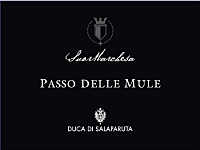
|
|
SuorMarchesa Passo delle Mule 2006 |
|
| Duca di Salaparuta (Sicily, Italy) | |
| Grapes: Nero d'Avola | |
| Price: € 8.50 | Score: |
| SuorMarchesa Passo delle Mule shows a brilliant ruby red color and nuances of ruby red, moderate transparency. The nose reveals intense, clean, pleasing and refined aromas which start with hints of black cherry, plum and violet followed by aromas of blackberry, blueberry, raspberry, chocolate, pink pepper and vanilla. The mouth has good correspondence to the nose, a slightly tannic attack and however balanced by alcohol, good body, intense flavors, pleasing roundness. The finish is persistent with flavors of black cherry, plum and blackberry. SuorMarchesa Passo delle Mule ages for 10 months in barrique followed by 8 months of aging in bottle. | |
| Food Match: Broiled meat and barbecue, Stewed meat with mushrooms, Hard cheese | |
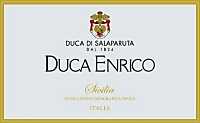
|
|
Duca Enrico 2004 |
|
| Duca di Salaparuta (Sicily, Italy) | |
| Grapes: Nero d'Avola | |
| Price: € 35.00 | Score: |
| Duca Enrico shows an intense ruby red color and nuances of ruby red, little transparency. The nose reveals intense, clean, pleasing, refined and elegant aromas which start with hints of black cherry, blackberry and plum followed by aromas of violet, vanilla, tobacco, blueberry, pink pepper, chocolate, cinnamon, mace and menthol. The mouth has good correspondence to the nose, a tannic attack and however balanced by alcohol, full body, intense flavors, pleasing roundness. The finish is very persistent with long flavors of plum, blackberry and black cherry. Duca Enrico ages for at least 18 months in cask followed by 12 months of aging in bottle. | |
| Food Match: Game, Roasted meat, Braised and stewed meat, Hard cheese | |
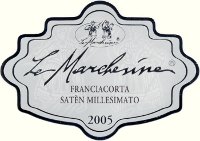
|
|
Franciacorta Satèn Millesimato 2005 |
|
| Le Marchesine (Lombardy, Italy) | |
| Grapes: Chardonnay | |
| Price: € 30.00 | Score: |
| Franciacorta Satèn Millesimato shows a brilliant straw yellow color and nuances of straw yellow, very transparent, fine and persistent perlage. The nose reveals intense, clean, pleasing and refined aromas which start with hints of banana, pear and bread crust followed by aromas of kiwi, yeast, acacia, pineapple, hazelnut, apple and pear. The mouth has good correspondence to the nose, an effervescent and crisp attack, however balanced by alcohol, good body, intense flavors, agreeable. The finish is persistent with flavors of banana, pear and kiwi. The base wine ferments in barrique. Franciacorta Satèn Millesimato referments in bottle on its lees for at least 30 months. | |
| Food Match: Sauteed fish, Pasta and risotto with crustaceans, Broiled crustaceans | |
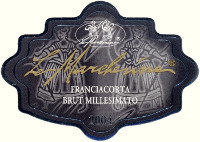
|
|
Franciacorta Brut Millesimato 2004 |
|
| Le Marchesine (Lombardy, Italy) | |
| Grapes: Chardonnay | |
| Price: € 35.00 | Score: |
| This Franciacorta Brut Millesimato shows a brilliant straw yellow color and nuances of greenish yellow, very transparent, fine and persistent perlage. The nose reveals intense, clean, pleasing and refined aromas that start with hints of apple, banana and bread crust followed by aromas of hawthorn, praline, pear, hazelnut, medlar, yeast and plum. The mouth has good correspondence to the nose, an effervescent and crisp attack, however balanced by alcohol, good body, intense flavors, pleasing roundness. The finish is persistent with flavors of banana, apple and plum. This Franciacorta Brut Millesimato referments in bottle on its lees for 36 months. | |
| Food Match: Stuffed pasta, Roasted fish, Roasted white meat, Mushroom soups | |
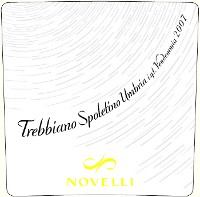
|
|
Trebbiano Spoletino 2008 |
|
| Cantina Novelli (Umbria, Italy) | |
| Grapes: Trebbiano Spoletino | |
| Price: € 8.90 | Score: |
| Blanc de Blanc Brut Millesimé shows an intense greenish yellow color and nuances of greenish yellow, very transparent, fine and persistent perlage. The nose reveals intense, clean and pleasing aromas which start with hints of apple, pear and citrus fruits followed by aromas of hawthorn, pineapple and plum. The mouth has good correspondence to the nose, an effervescent and crisp attack, however balanced by alcohol, good body, intense flavors. The finish is persistent with flavors of apple, pear and plum. Blanc de Blanc Brut Millesimé referments in bottle on its lees for 10 months. | |
| Food Match: Vegetable soups, Pasta and risotto with fish and mushrooms, Stewed fish | |
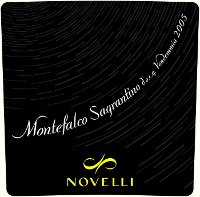
|
|
Montefalco Sagrantino 2005 |
|
| Cantina Novelli (Umbria, Italy) | |
| Grapes: Sagrantino | |
| Price: € 18.00 | Score: |
| Montefalco Sagrantino shows an intense ruby red color and nuances of ruby red, little transparency. The nose reveals intense, clean, pleasing and refined aromas which start with hints of blackberry, black cherry and plum followed by aromas of vanilla, violet, blueberry, cocoa, tobacco and menthol. The mouth has good correspondence to the nose, a tannic attack and however balanced by alcohol, full body, intense flavors. The finish is persistent with flavors of blackberry, black cherry and plum. Montefalco Sagrantino ages for 16 months in barrique. | |
| Food Match: Game, Roasted meat, Braised and stewed meat, Hard cheese | |
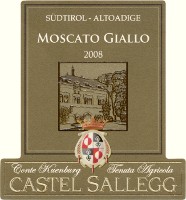
|
|
Alto Adige Moscato Giallo 2008 |
|
| Castel Sallegg (Alto Adige, Italy) | |
| Grapes: Moscato Giallo | |
| Price: € 9.60 | Score: |
| Alto Adige Moscato Giallo shows a brilliant greenish yellow color and nuances of greenish yellow, very transparent. The nose denotes intense, clean, pleasing and refined aromas that start with hints of grape, banana and peach followed by aromas of citrus fruits, pear, apple, sage and lavender. The mouth has good correspondence to the nose, a crisp attack and however balanced by alcohol, good body, intense flavors, agreeable. The finish is persistent with flavors of grape, peach and pear. Alto Adige Moscato Giallo ages in steel tanks. | |
| Food Match: Vegetable soups, Broiled crustaceans, Sauteed crustaceans, Risotto with crustaceans | |
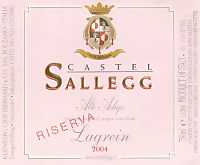
|
|
Alto Adige Lagrein Riserva 2004 |
|
| Castel Sallegg (Alto Adige, Italy) | |
| Grapes: Lagrein | |
| Price: € 13.10 | Score: |
| Alto Adige Lagrein Riserva shows an intense ruby red color and nuances of ruby red, little transparency. The nose reveals intense, clean, pleasing and refined aromas that start with hints of black cherry, blackberry and plum followed by aromas of violet, blueberry, black currant, vanilla, tobacco, chocolate and mace. The mouth has good correspondence to the nose, a tannic attack and however balanced by alcohol, good body, intense flavors, agreeable. The finish is persistent with flavors of plum, black cherry and blackberry. Alto Adige Lagrein Riserva ages for 18 months in barrique and cask. | |
| Food Match: Roasted meat, Stewed and braised meat, Hard cheese | |
|
||||||||
|
DiWineTaste Polls
|
| |||||||
Privacy Policy | |||||||


| Copyright © 2002-2024 Antonello Biancalana, DiWineTaste - All rights reserved |
| All rights reserved under international copyright conventions. No part of this publication and of this WEB site may be
reproduced or utilized in any form or by any means, electronic or mechanical, without permission in writing from DiWineTaste. |